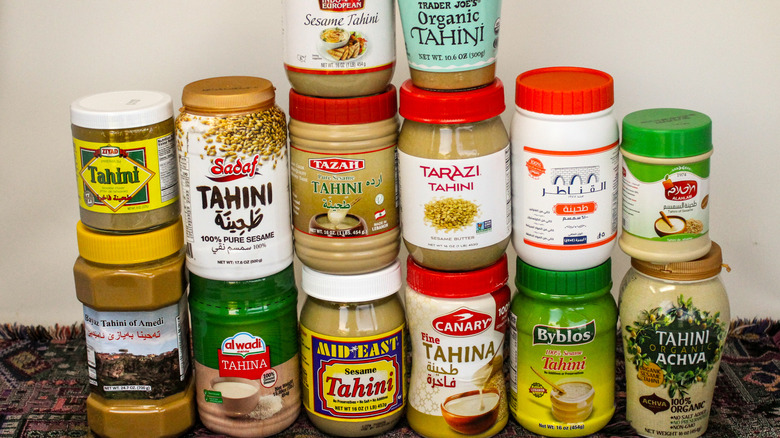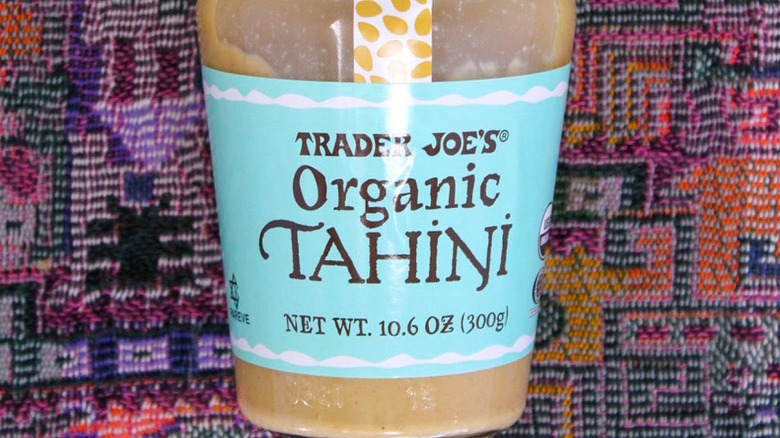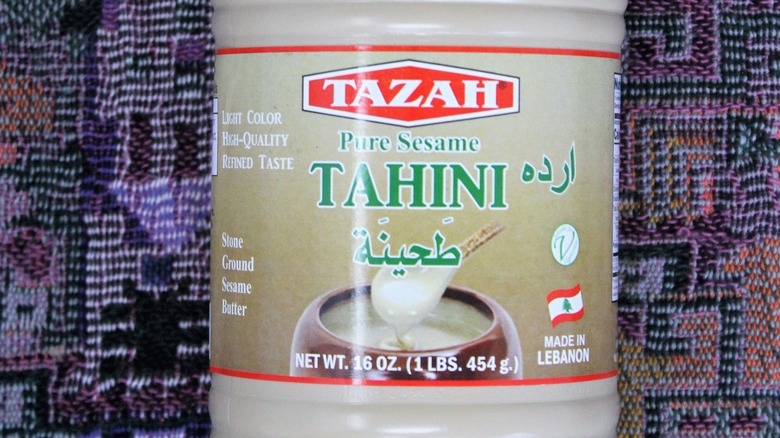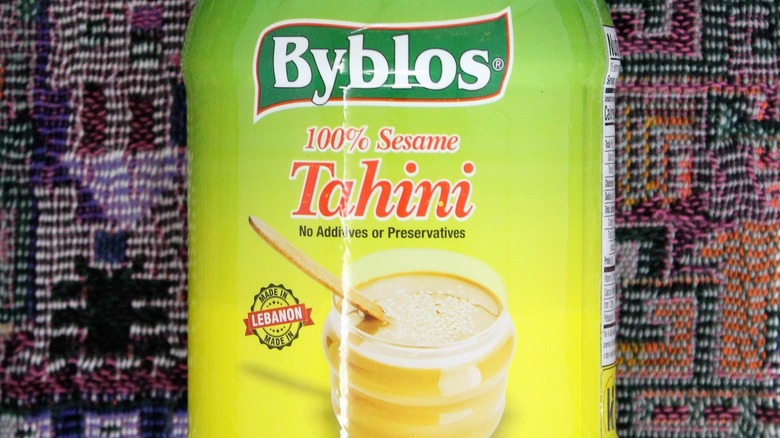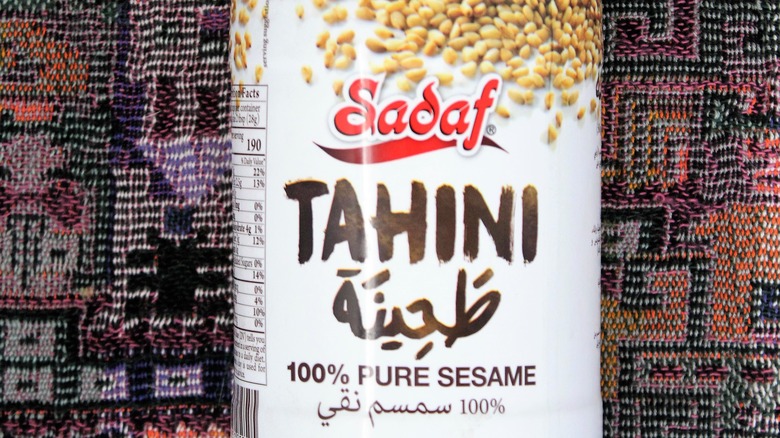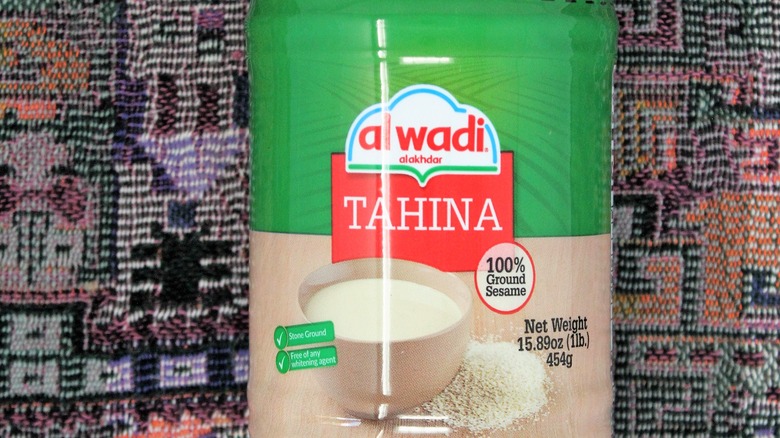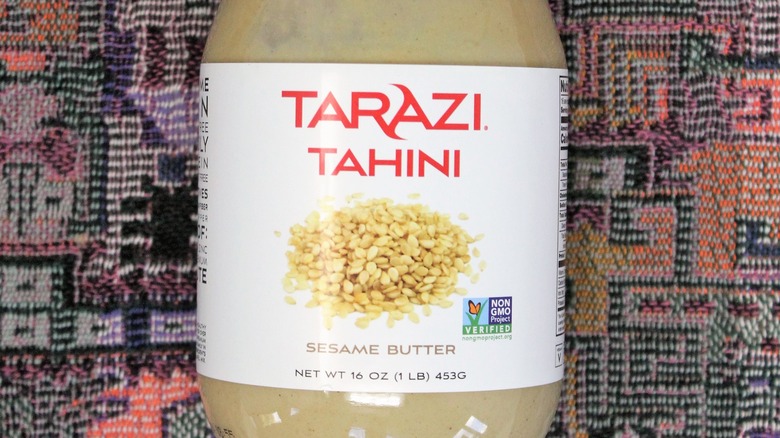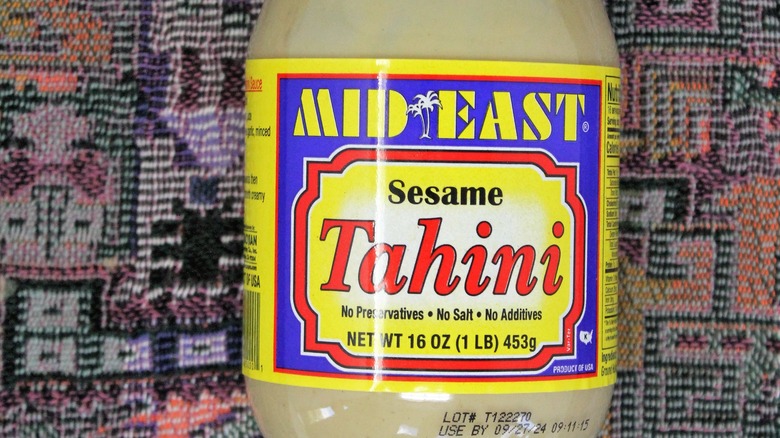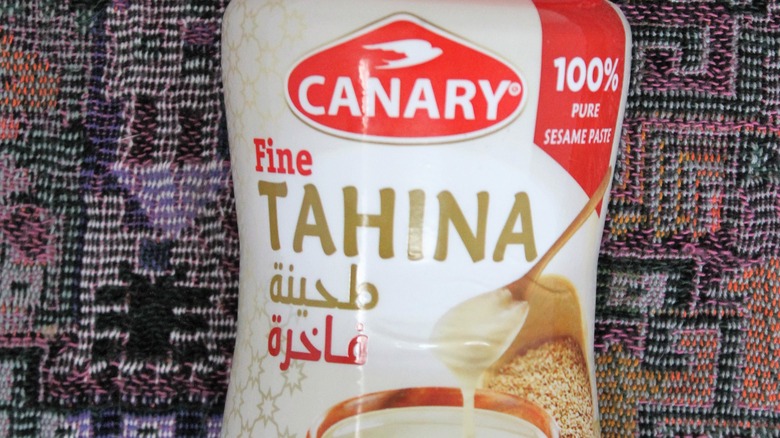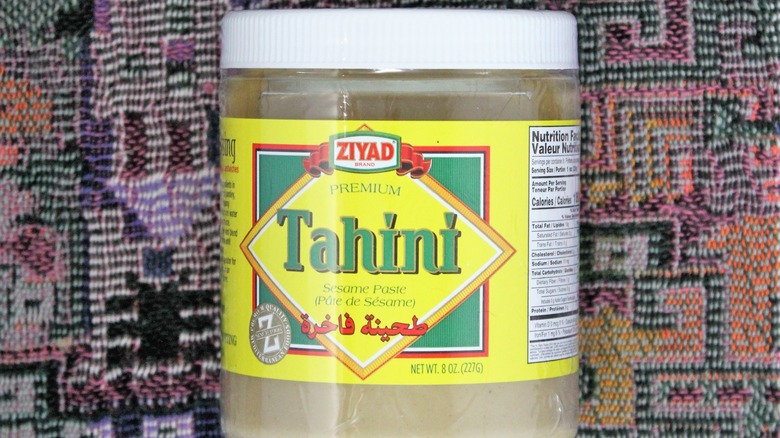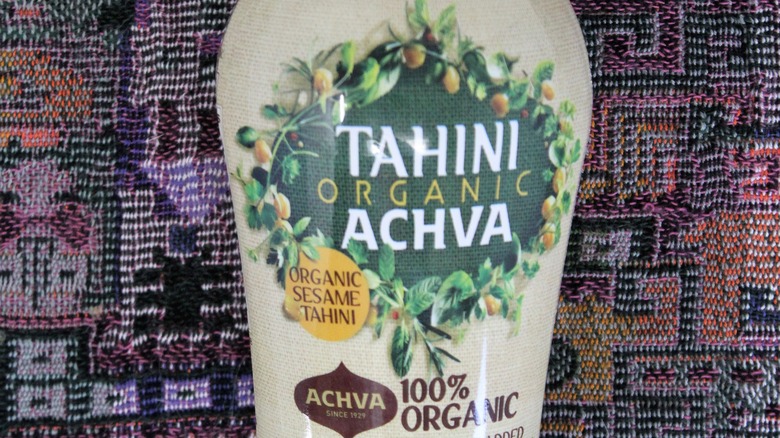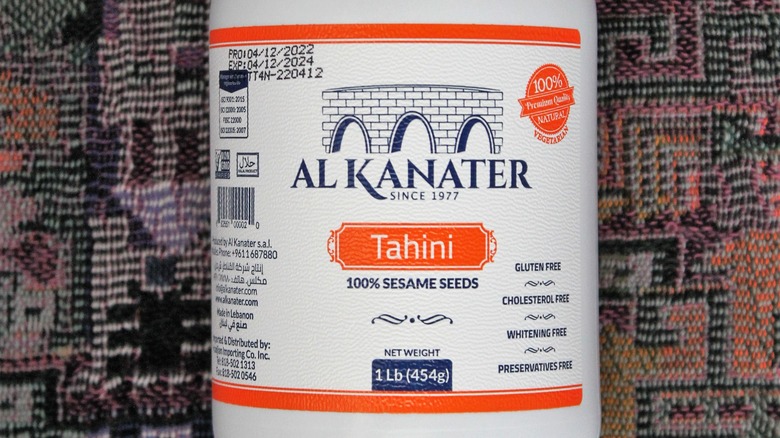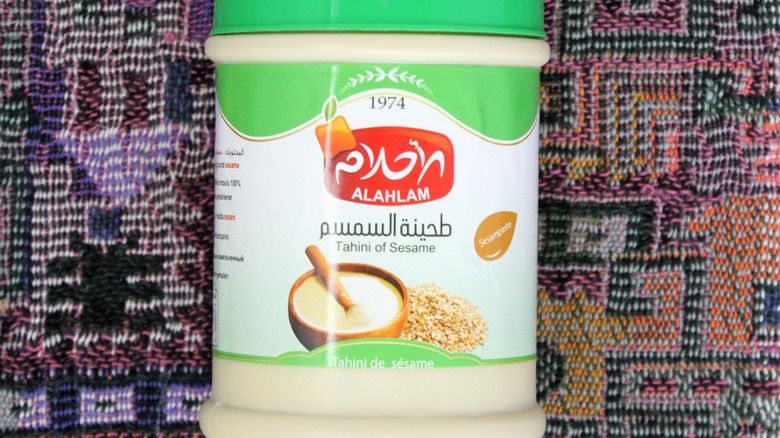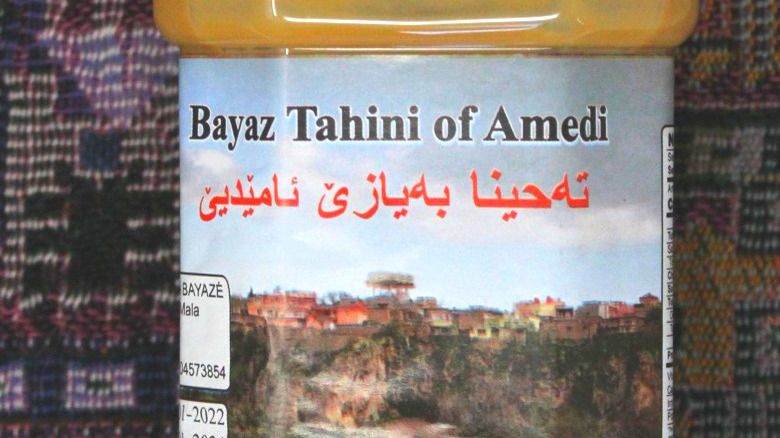The 13 Best Store-Bought Tahini, Ranked
Tahini! It's not just for hummus anymore. Nor is it merely eggplant's creamy sidekick in baba ganoush. Tahini is an ingredient that is just as at home in sweet treats like cookies as it is in the savory kitchen. From sauces for lamb or roasted zucchini to blondies, it may be more challenging to figure out what you cannot do with tahini than it is to suss out creative new ways to use this remarkably flexible ingredient.
What exactly is tahini in the first place? Technically, it is sesame seed butter, though it is commonly referred to as a "nut butter," per the Auguste Escoffier School of Culinary Arts. That pretty much makes it peanut butter's first cousin. And, according to Eating Made Easy, a healthier cousin at that. Healthy and versatile as tahini may be, it is an essential ingredient in the Middle East, as The New York Times explains. It's not just important; it's really important. Indeed, it's a veritable "staple." While there are many types of tahini (hulled or unhulled, as well as roasted, toasted, or raw), they're all incredibly simple. Every single tahini contains exactly one ingredient: sesame seeds ground to a smooth paste.
While you can make tahini yourself, not everyone has both the time and inclination to do so. Besides, there is no shortage of excellent options on store shelves. We're here to help you sort through some common brands of tahini to let you know which ones are worth buying.
13. Trader Joe's Organic Tahini
Trader Joe's Organic Tahini was, by far, the least impressive of the tahini products we tried. The first hint of the problems to come arrived with a veritable oil slick at the top of the bottle. The major congealed layer of solid, compressed ground sesame seed was not much more appetizing. It was, to say the least, a major effort even to begin bringing the two together. In fact, it never happened for us and, quite possibly, has never happened in recorded history.
The flavor experience was not much better. Yes, there was an evident hint of nuttiness to be found. But if "bland" is a flavor, it is also the proper descriptor for this tahini.
Oh, there's a vague nuttiness in there. Frankly, though, it took a lot of work to find even that. What little flavor there was in this tahini likely resulted from the fact it is made with hulled seeds that were likely roasted. Adding a bit of water to the tahini out of the bottle can sometimes yield benefits in texture and even open up the flavor. Not here. The only real effect of the water was to mute what few redeeming flavors the tahini had to start with.
12. Tazah Pure Sesame Tahini
Upon opening the Tazah Pure Sesame Tahini, there was a fair amount of oil at the surface. Unlike some tahinis we tasted, the lower portions of the bottle were uncongealed. As a result, the tahini was re-emulsified with a fair amount of stirring by fork, along with some vigorous bottle shaking. Tazah's texture was workable, if not exactly creamy. The flavor profile of the Tazah's tahini was generally warm with a hint of nuttiness.
Flavor, to be clear, is really not this tahini's calling card. It was not born to be the star of a dish but more of a supporting player. Pair Tazah's tahini with something that brings a bit more of its own star qualities to the party. If you're going to use the tahini in a tahini sauce, for example — and why wouldn't you — opt to go with a flavored version by buzzing in minced, strongly flavored herbs or tomato paste.
11. Byblos 100% Sesame Tahini
A "hockey puck" is not one of the things you hope to find in a jar of tahini, but it is, indeed, what we found just below a significant oil layer at the top of the Byblos 100% Sesame Tahini. Discovering oil at the top of a store-bought tahini bottle is hardly unusual, but finding it in the quantity here was. And where you see oil on top, it is reasonable to expect some corresponding congealed solids came out of suspension. On the other hand, the hockey puck in question was exceptional. A spoon didn't penetrate it. A bread knife didn't penetrate it. Repeated stabbings with a steak knife (we didn't want to risk more pricey cutlery) ultimately did the trick.
After extensive work, we did manage to get the tahini back into suspension and the result, at least in texture, was satisfying. If tahini came in "creamy" and "nutty" — kind of (but not exactly) like a certain peanut butter brand — Byblos' tahini would definitely be the poster child for creamy. Nutty? Not so much. Byblos' flavor, charitably put, is subtle.
10. Sadaf 100% Pure Sesame
Upon opening the bottle of Sadaf 100% Pure Sesame, we were greeted by a big layer of oil sitting atop a solidified mass of ground sesame. We would be fibbing if we said that was other than a source of concern. We breathed a sigh of relief for a moment when a few strokes of a fork appeared to bring the tahini back together. That exercise, though, just got us to the next solidified layer below. This was not a welcome greeting. It is also not clear without testing additional examples of the same bottling whether this was the result of that particular bottle sitting on the store shelf too long or emblematic of a more serious flaw.
One reason to think the explanation might be the former was the fact that Sadaf's tahini tasted good, really good. It was among the richest in the tasting, with hints of toasty, roasted flavors, honey sweetness, and a touch of salinity. Richness and a flavor profile with complexities are good things, so we'll score this one as inconclusive.
9. Alwadi Tahina
Flavor is king, and that's what earns Alwadi Tahina good marks. Yes, Alwadi's tahini shouts "nutty" in a very direct sort of way, but there's also a hint of salt that tickles the tongue. It just tastes good!
That's enough to encourage us to ignore the significant layer of oil that greets us upon opening the bottle. The fact that a few stirs of a fork begin to bring the tahini back into suspension helps. After that, though, a significant solid layer remains down at the bottom.
Alwadi's tahini, though, really shined when the stuff out of the bottle was loosened with a bit of ice water. That did wonders for the texture of the tahini. Even more than the texture, though, that water trick sharpened the flavors, defining them. A bit of acid (lemon juice) or honey — both Middle Eastern staples — added in with the water couldn't hurt.
8. Tarazi Tahini Sesame Butter
Tarazi Tahini Sesame Butter was somewhat similar in style to Alwadi's tahini. Again there was an evident separation of the oil in the sesame paste from its solids. That is to be expected. Instead of a big congealed (whether totally solid or otherwise) mass below, though, there was just a thicker suspended layer. And even that was quickly resolved with a few swirls of a fork and a handful of shakes of the bottle. Like the Alwadi, Tarazi's product has a deep nutty flavor with hints of salt.
It is the texture of the Tarazi tahini, though, that really stands out. It is smooth and creamy in texture with a luxurious feel. Tarazi would be the perfect tahini to use for baba ganoush.
Tarazi's tahini is made in California and subscribes to the Cali-ethic. Like most tahini, it is kosher, vegan, gluten-free, and dairy free. In addition, Tarazi is made in a nut-free facility and is both organic and non-GMO.
7. Mid East Sesame Tahini
Texturally, Mid East Sesame Tahini is similar to Tarazi's product. A slight layer on top and the separated material below was easily brought together by a few vigorous shakes of the tahini bottle. There was no congealed mass and no hockey puck in evidence.
From a flavor perspective, the only real similarity between those two tahinis was the fact they were both tasty. They were good, though, in different ways. Where Tarazi's flavor focuses on tahini's nuttiness, Mid East's product is focused on richness. Indeed, it was rich in ways that were one part buttery and one part nutty. Beyond that, Mid East's tahini also had bright, almost acidic notes on the finish.
It is those subtle flavor notes combined with the richness of Mid East's tahini that suggests it should be used in ways to make it the star of the dish. It would be an excellent choice of tahini to use in any dessert applications, like tahini cookies.
6. Canary Tahina
As with most of the tahinis we tasted, there was a slight separation of solids and liquids evident upon first opening the bottle of Canary Tahina. That is to be expected with nearly any store-bought tahini. Of course, as with most of the better tahinis in the tasting, that slight separation of oil and solids all came back together after a few shakes of the bottle. A fork would also have done the trick, but some bartender-style shakes got the tahini texture where it needed to be without any extra effort or cleanup.
Regarding the flavor, Canary's tahini product featured a strong creamy and buttery richness along with a slight hint of sweetness. Again, that would make it a good choice for applications out of the sweet world. The buttery richness would also make it an excellent choice for a tahini salad dressing or a marinade for grilled chicken.
5. Ziyad Premium Tahini
The hallmark of Ziyad Premium Tahini is deep nutty flavors with strong roasted notes. While "creamy" and "luscious" might sound like descriptions of texture (and they most definitely are the proper descriptors of the texture of Ziyad's tahini), they rose to the level of flavor here. We could taste the creaminess, and we luxuriated in the lusciousness.
That creaminess and lusciousness are enough to help us overlook the significant oil layer at the top of the bottle upon opening. In contrast to some of the better tahinis we tasted, the congealed part of Ziyad tahini was neither solid nor even a gluey mass. It all comes together with ease, resulting in a luxurious, even silky texture.
And that texture is part of why Ziyad would be the perfect tahini to use as the basis for a tahini sauce. Pair that sauce with Middle Eastern shawarma, Greek gyros, or Turkish kebabs.
4. Achva Organic Tahini
It is the complexity of the flavor and smoothness of the texture of Achva Organic Tahini that earns it a spot near the top of our rankings. From the flavor perspective, Achva's tahini features nuttiness that is absolutely prototypical (only deeper, if that's possible) and richness (only more so than most). Achva Organic Tahini also features sweet, even aromatic notes that suggest honey and flowers. In flavor, Achva features everything a tahini should feature and nothing it should not.
The slight oil layer upon opening the bottle is to be expected. Because the solids that came out of the solution are not congealed, the texture of the tahini comes together efficiently. The result is a smooth texture that makes Achva's Organic Tahini perfect for sandwiches. Swap out the tahini for peanut butter and make a tahini and jelly sandwich. Or use tahini as the glue and sauce in a grilled vegetable sandwich.
3. Al Kanater Tahini
Sometimes, it seems, complexity is overrated. Baseball scouts rave about their latest discovery of another five-tool player. Some of the greatest players in baseball history were among those. For every one of those, though, dozens don't even make it. Al Kanater Tahini, to carry out the analogy, is the ball player who could just do one thing: hit home runs.
The first job of tahini is to taste good. And that's what puts Al Kanater — a Lebanese brand — towards the top of our picks. Buttery, featuring distinctly nutty and rich flavors of sesame seeds, Al Kanater is unquestionably one of the richest tahinis we tasted. Rich as it is, Al Kanater Tahini's flavor profile is clearly not among the most complex we tasted. Indeed, quite to the contrary: Al Kanater's tahini is a straightforward powerhouse. What it may lack in subtle complexities, it more than makes up for in outright buttery richness.
Texturally, Al Kanater is a gem: smooth, creamy, and utterly luscious. It is about as perfect in texture as a store-bought tahini could possibly be. And Al Kanater's wonderful texture did yeoman's work perfectly, complementing the rich, nutty and buttery flavor profile of the sesame seed paste. It was a home run.
2. Alahlam Tahini of Sesame
Tasty and complex, Alahlam Tahini of Sesame richly deserves its place as one of the two best tahinis we tried. Alahlam is the creamiest of the bunch, and it achieves that — as did some of the better tahinis we tasted — by blurring the distinction between a texture and a flavor. Alahlam did not stop there, though. Just below that luscious creaminess was vaguely acidic notes in the tahini that served, if anything, to highlight the richness.
This is the sort of tahini that should be used in as simple and direct a way as possible. A little water, lemon juice, salt, and a bit of garlic (and vigorous whisking) is the most one should do with a tahini this good. Just about anything more would be a waste. Frankly, this is the kind of stuff you should eat right out of the bottle. Alahlam? Check. Spoon? Check. Good to go.
1. Bayaz Tahini of Amedi
As good as the Alahlam may have been, it did not rise to the level achieved by Bayaz Tahini of Amedi, the out-and-out absolute standout tahini of the bunch. It tasted the best and had the best texture; we cannot imagine what one could not do with it. Use it for a simple tahini sauce or a dressing on meat. You could certainly use it for a classic like baba ganoush or go in a sweeter direction. For any of those applications, Bayaz Tahini of Amedi would be the best choice amongst those we tested.
Bayaz's tahini features deeply complex, nutty flavors — some distinctly sesame but also with hints of a wider array of seeds and nuts. Those nutty flavors are highlighted by salty notes with hints of sweetness, as well as floral and herbal notes. Bayaz's textures were every bit as perfect as its flavors. None of the tested tahinis were better (either in taste or texture) straight out of the bottle, and none fully re-emulsified more easily.
While there is nothing we can think of that Bayaz would not do well in, it is difficult not to dream about using it for hummus. Perhaps with roast beets to take advantage of the salty and sweet notes of the Bayaz product. And the pinkish, purplish color of the resulting hummus would look as good as it tastes.
